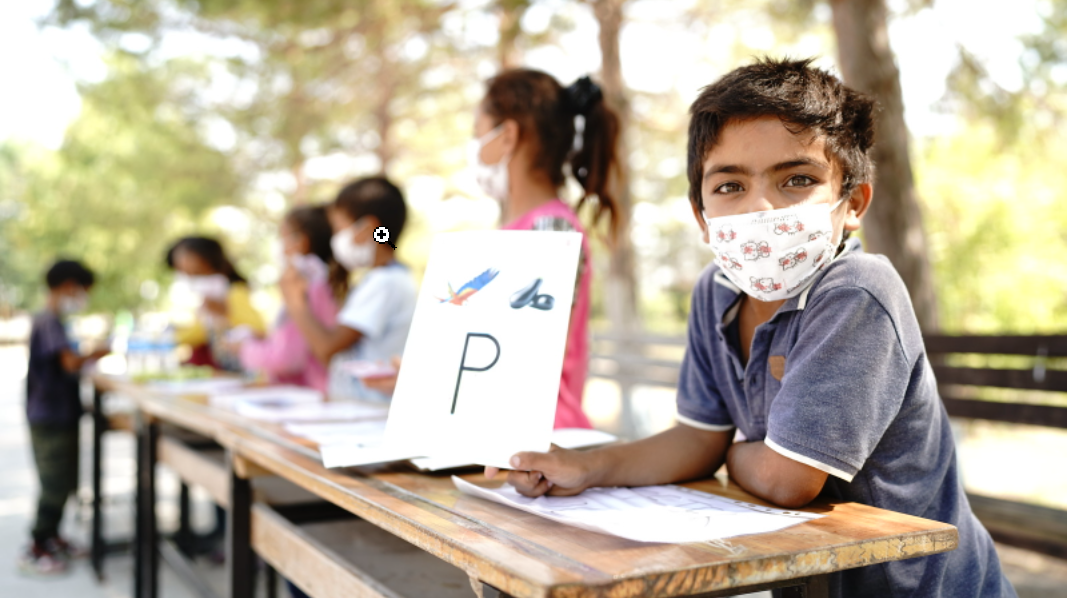7.1 Chapter Overview

Figure 7.1. Learning During COVID-19.
“You’re on mute” may be the most commonly heard phrase in education during the COVID-19 pandemic.
You probably can tell stories about how hard it has been to stay in school during the COVID-19 pandemic (figure 7.1). Some of you may have a couple of kids in school, with a computer at home that needs to be shared between the three of you, and no internet. You may have struggled to get your six-year-old to wear a mask so that they could go to school. Others of you were able to get computers and hotspots from your schools, but you weren’t quite sure about how to get on to Zoom or how to convince your middle schooler to stay on line.
For students who needed physical therapy or speech therapy to succeed, doing therapy online, even when it was available, was a poor substitute for in-person care. Some of you needed to quit school for a while so that you could take care of your kids or your sick family members. Still others of you graduated high school, but didn’t get a chance to have a graduation ceremony or celebrate with others.
For others, school at home became a time in which students flourished because they could learn at their own pace. Students from wealthy families might get better grades because their parents were able to hire teachers to teach their kids one on one. Some parents could put their kids in learning pods, small socially isolated groups of kids with one teacher. For introverts like me, quarantine had an unexpected benefit. I could focus on creative projects without having to leave home.
Many of us have stories to tell about how the pandemic has impacted our education. For a bird’s eye view of how COVID-19 shaped education, please watch the 11:14-minute video, “Education Crisis during COVID-19” in figure 7.2. As you watch, please consider the following questions:
- How has COVID-19 impacted the experience of education?
- How has technology made learning more or less accessible?
- Are the experiences of the students in this video the same as yours? What might be the reason for the difference?
Figure 7.2. How coronavirus lockdowns disrupted education systems worldwide | COVID-19 Special [YouTube Video] (time 11:14 minutes).
Our experience of education during this pandemic also illustrates the interdependence of our educational system. Both the federal government and the Oregon Governor’s office made rules about what social distancing looked like and when schools could be open. Our teacher’s unions advocated for the safety of everyone in our schools. Some of our teachers, cafeteria workers, and school bus drivers staffed food deliveries for our most vulnerable students on school bus routes. Our janitors implemented safety protocol after safety protocol. And all of us learned with our technology professionals to find computers, hotspots, and other technologies and get them into our student’s hands.
Each of our COVID-19 education stories is a bit different. As we widen our lens to look at education in our society, we see that education itself can be both a force for social change and a barrier to social change. In this chapter, we will explore your experience with going to school during COVID-19 so that we can see how the pandemic reveals the need for social change and creates opportunities for social change to happen.
After we learn each other’s stories, we begin to build our sociological understanding. We explore the various functions of the institution of education, from teaching needed skills to thrive in our society, to maintaining social and cultural inequality, to being a tool in a bigger agenda of genocide. We look even deeper at who gets educated, examining the intersections of race, class, gender, ability and disability in the United State and the world. The inequality we see in the institution of education provides the background of understanding why we need social change.
In the last half of the chapter, we examine the potential for the institution of education to be a driver of social change. We explore the relationship between education, wealth, and income, untangling whether going to school can make you richer and, at a deeper level, whether education can contribute to economic growth in countries. We also look at how our education system has changed over time, including the emerging movements to leverage education as a method for creating transformative social change. We end this chapter how we started, looking at how the global pandemic has provided the impetus to address the digital divide, a social change that impacts many of us, our families, and our communities.
In this chapter, we’ll explore the following questions:
- What is the function of education in our society?
- How does education serve to reproduce economic inequality?
- How does social location, including race, gender and class, impact access to education, educational outcomes and social change?
- What are some of the current and emerging movements for social change in education, including new applications of Pablo Freire’s Pedagogy of the Oppressed?
- How does the introduction of technology in education provide opportunities to support or reduce social inequality?
7.1.1 Licenses and Attributions for Chapter Overview
“Chapter Overview” by Kimberly Puttman is licensed under CC BY 4.0.
Figure 7.1. Learning During COVID-19. Photo by Fatma Cankara /ILO. Licensed under CC BY-NC-ND 2.0.
Figure 7.2. Covid Education video How coronavirus lockdowns disrupted education systems worldwide | COVID-19 Special
